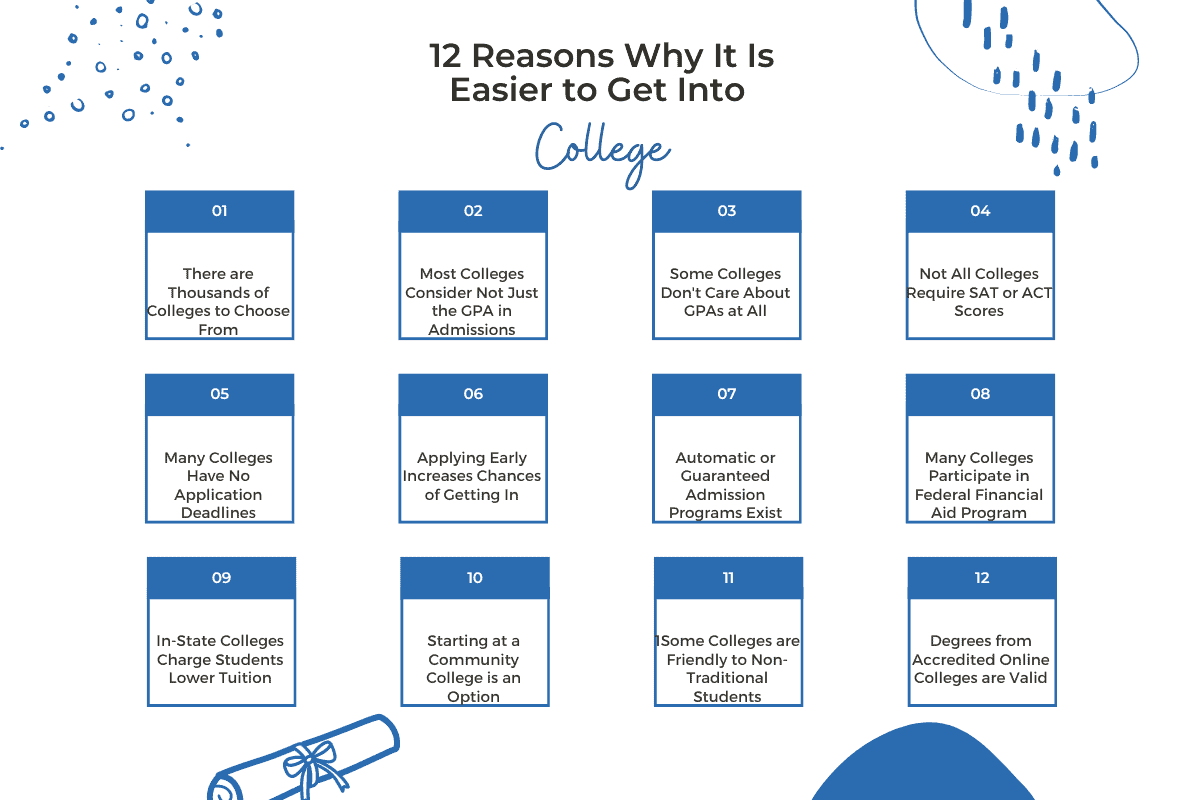12 Reasons Why It is Easy to Get Into College
College — the word alone is enough to send chills down the spine of many junior and senior high school students, particularly those who are unhappy with their curricular performance and extracurricular engagements. However, in many instances, the narrative that admission to college is near impossible isn’t true, and an undergraduate degree is actually more accessible.
It’s easier to get into college than most people think because…

1. There are Thousands of Colleges to Choose From
Did you know that there are almost 4,000 education institutions in the US that grant degrees? So, in other words, the 8 Ivy Leagues as well as the handful of other prestigious schools that tend to scare away many students due to their ridiculously low acceptance rates are just the very small tip of the iceberg — there are so many other colleges to apply to!
Plenty of those nearly 4,000 schools will be more than willing to admit you. All you have to do is find them.
The following are some various types of colleges you might want to look into:
- Private universities
- Public universities
- Research universities
- For-profit colleges
- Liberal arts colleges
- Community colleges
- Work colleges
2. Most Colleges Consider Not Just the GPA in Admissions
Refrain from assuming that a low GPA disqualifies you from applying to selective colleges. While it’s true that your GPA will probably be the first thing admissions officers at those schools will look at, they will also check out other things on your application. Up to 95% of selective institutions in the US, believe it or not, have a holistic admissions policy.
But make sure that most of the components of your application are stellar enough to make up for a low GPA.
Some colleges with a holistic admissions policy are listed below:
- Bates College
- Bryn Mawr College
- Harvard University
- Johns Hopkins University
- Stanford University
- University of Chicago
- University of Pennsylvania
- Wake Forest University
- Wesleyan College
3. Some Colleges Don’t Care About GPAs at All
Some postsecondary institutions consider many things in the review process, including the GPA. However, there are also those that do not consider the GPA when making admissions decisions — all they care about is that applicants have a high school diploma or even an equivalent, such as the General Educational Development (GED) diploma.
Colleges that require only a high school diploma or a similar credential are open enrollment or admissions schools.
Here are some open enrollment institutions where an applicant’s GPA doesn’t matter:
- Arlington Baptist College
- Baker College
- Cameron University
- Granite State College
- Missouri Western State University
- Northwestern Polytechnic University
- Oklahoma Panhandle State University
- University of the Potomac
- Weber State University
4. Not All Colleges Require SAT or ACT Scores
The vast majority of college applicants these days do not have to feel pressured to submit their test scores.
Over 80% of colleges and universities in the US are either test-blind or test-optional. Test-blind schools refuse to consider SAT or ACT scores in the admissions process even if they are submitted. Test-optional schools, meanwhile, consider test scores only if submitted. So, in other words, a bad score should not intimidate you from applying to college.
Below is a list of some test-blind colleges that you might want to check out:
- California Institute of Technology
- Dickinson College
- Northern Illinois University
- Pitzer College
- Reed College
- Stonehill College
- University of California system
- University of San Diego
- Worcester Polytechnic Institute
5. A Lot of Colleges Have No Application Deadlines
Nothing can be more devastating to a college-bound teen than getting his or her application ready and then completely missing the application deadline to his or her top-choice school.
It’s a good thing that more than 25% of American institutions of higher education have a rolling admissions policy, which means that they accept applications all year round — no hard deadlines to beat! Still, it’s considered a good idea to submit your application as early as you possibly can before all available slots to fill get filled.
These are some examples of colleges and universities with an open admissions policy:
- Binghamton University
- Indiana University – Bloomington
- Loyola University Chicago
- Purdue University – West Lafayette
- Rutgers University
- Saint Louis University
- University at Buffalo
- University of Minnesota – Twin Cities
- University of Pittsburgh
6. Applying Early Increases Chances of Getting In
While some colleges welcome applications anytime of the year, some colleges start accepting applications earlier than early January, which is the deadline for the regular decision round at many institutions. These schools have early decision and early action plans, both of which can help increase an applicant’s chances of getting in.
But it’s a must for interested high schoolers to know that they will have to act fast as the deadline is usually November 1, plus the ED plan is binding — accepted students must matriculate!
According to Niche, some of the top early decision colleges are as follows:
- Brown University
- Columbia University
- Dartmouth University
- Duke University
- Northwestern University
- Rice University
- University of Chicago
- University of Pennsylvania
- Vanderbilt University
- Washington University in St. Louis
7. Automatic or Guaranteed Admission Programs Exist
Making college applications stressful and exhausting is that there are all kinds of documents to get hold of and all sorts of deadlines to remember. The good news is that many colleges have automatic or guaranteed admission programs, which, as the name suggests, ensures high school graduates a spot on their campuses provided that they meet eligibility requirements.
Some examples of schools with such a program include:
- Arizona State University
- Texas A&M University
- Truman State University
- Tulane University
- University of Kansas
- University of Texas at Austin
- Washington State University
8. Many Colleges Participate in Federal Financial Aid Program
It’s quite common among many low-income students to assume that college isn’t for them because of exorbitant tuition and fees. However, filling out the FAFSA allows them to be eligible for financial aid to cover the cost of college. As a matter of fact, more than 85% of college students in the US receive some form of financial aid, according to National Center for Education Statistics (NCES).
A lot of colleges that do not participate in federal student aid offer institutional or programmatic aid.
The following institutions are known to have some of the most generous financial aid offers:
- California Institute of Technology
- Grinnell College
- Pomona College
- Princeton University
- Vanderbilt University
- Vassar College
- Williams College
- Yale University
9. In-State Colleges Charge Students Lower Tuition
Other than applying for aid, another step high schoolers whose families cannot afford college may take is to apply to public institutions. But they should refrain from applying to just about any government-funded schools — they should apply to public in-state colleges, or public colleges that are located in their state of residence.
Despite having to pay lower tuition costs, in-state students can still apply for state and federal aid.
Below are some flagship colleges and universities with some of the lowest tuition for in-state students:
- University of Florida
- University of Idaho
- University of Montana
- University of New Mexico
- University of Wyoming
10. Starting at a Community College is an Option
The average tuition at community colleges is thousands of dollars cheaper than tuition at public and private universities — $3,862 vs. $9,377 (in-state) vs. $37,641 (non-profit). Low-income students may take advantage of this fact by spending the first 2 years of their college career at a community college and then spending the other 2 at a 4-year institution.
Going for a community college with some kind of articulation agreement with a university is a smart move.
Below are some of the best community colleges for transferring to a university:
- Alabama Southern Community College
- De Anza College
- Ellsworth Community College
- Garrett College
- Hibbing Community College
- Itasca Community College
- Lake Region State College
- Minnesota State Community and Technical College
- Vermilion Community College
11. Some Colleges are Friendly to Non-Traditional Students
Did you know that around 73% of higher education students fit the non-traditional mold?
Because being a non-traditional student is so much more common than you think, graduating from high school some time ago, being older than 24 years old, having a job or raising kids should not keep you from going to college. Many institutions of higher education are non-traditional student-friendly by offering flexible schedules, hybrid classes and others.
Here are some colleges that tend to attract a lot of non-traditional students:
- Eckerd College
- Lewis-Clark State College
- Liberty University
- Portland State University
- Southern New Hampshire University
- University of Houston
- University of Texas at Dallas
- University of Utah
12. Degrees from Accredited Online Colleges are Valid
Speaking of hybrid classes, another thing that makes getting into college easier now more than ever is that there are many accredited online learning institutions available, some of which serve as the online campuses of traditional colleges.
Due to the fact that online degrees, particularly those that are conferred by legit online schools, are comparable to degrees that you can earn from a physical campus, applying for a job or seeking a promotion should not be an issue.
These are some of the best accredited online colleges as per US News:
- Arizona State University
- George Washington University
- Oregon State University
- Texas A&M University
- University of Central Florida
- University of Florida
- University of Illinois – Chicago
- Utah State University
So, is it easy to get into college or not?
Getting admitted to college is actually easier than most students think.
Unfortunately for those who would love to have an associate or bachelor’s degree but are daunted by low acceptance rates, steep costs of attendance and other things, what they hear or read most of the time can discourage them completely.
For instance, it’s not uncommon for the media to constantly talk about nothing but the top 10 or top 20 schools, most of which can admit only as many applicants. Likewise, it gives the impression that there are not enough options available, especially for high school teeners with low GPAs and/or very little to no extracurricular participation.
Also, many resources on the web post tuition and fees and other costs without mentioning the fact that students can apply for financial aid, thus reducing the sticker price.
However, it’s important to keep in mind that certain admission trends may make it harder for certain types of students to get into college.
Disclaimer: The views and opinions expressed in this article are those of the authors and do not necessarily represent those of the College Reality Check.






